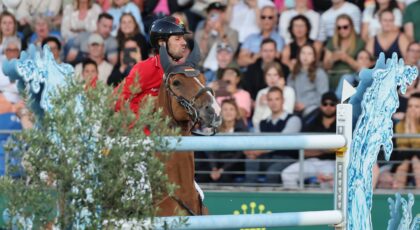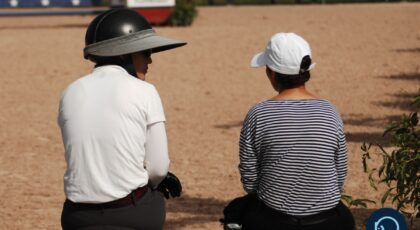North Carolina-based Olympic eventer Doug Payne is nothing if not versatile.
Currently sitting in the top 250 in the FEI Eventing World Athlete Rankings, over the last 30 years, Payne has completed 11, CCI5* events and has become a well-known name in U.S. eventing.
Now, he hopes to make the same impact in the discipline of show jumping full-time.
I’ve never been someone to chase quick results or make impulsive decisions,” Payne told Eventing Nation this week. “Everything we’ve done—whether it’s selling a horse or focusing on jumping-bred horses—has been for the greater good of our family and our business. This transition is just the next logical step.”
Payne and his wife, Jessica Payne, who has also competed up to the *5 level in eventing, already know a thing or two about tough choices. In 2014, the Paynes sold Doug’s championship-caliber mount Crown Talisman to the U.K. in order to purchase land and build their farm near Durham.
But if one’s past informs their present, Payne’s takeaway may have been to embrace new challenges, as the sale didn’t set him back for long.
In 2019, he and Starr Witness were part of the gold medal-winning U.S. team at the Pan American Games, finishing fourth individually. In 2021, Payne and the Trakehner gelding Vandiver became the highest-ranked U.S. pair at the Tokyo Olympic Games, finishing 16th. And, one year later, he and new top horse Quantum Leap finished third on the podium at the Kentucky Three Day, earning a USEF National CCI5*-L Championship for their trouble.
That 14-year-old DSP gelding—who Payne had produced since he was a yearling—retired in 2024, speeding up the rider’s planned transition into the show jumping ranks.
But even in this discipline, Payne is no stranger to FEI-level competition, having competed mounts Quintessence and Chaccolate RFB on the 5* Major League Show Jumping (MLSJ) circuit in 2024 at venues including Ottawa and Toronto.
What’s more: Payne has campaigned the North American-bred Oldenburg gelding Quiberon up to the 4* level in eventing, the 1.30m-level in show jumping, and in international hunter derbies—where he’s even earned ribbons. In a word: versatile.
According to the former eventer, perhaps the biggest difference between eventing and the hunter/jumper world is the travel involved. In years past, the Payne family was required to spend up to 90% of their time on the road—a fact that’s become increasingly difficult as their two children, Abigail and Hudson, have grown.
Now, with top hunter/jumper venues including Tryon virtually in their backyard, the family can cut that annual travel schedule in half. And Payne will hardly be the first successful eventing transplant in the international show jumping.
Two-time Olympic individual silver medalist (2016, 2021) Peder Fredricson competed for Sweden in the 1992 Olympic Games in eventing before making the switch. Meanwhile, 2015 Pan American team and individual eventing gold medalist Marilyn Little (USA) recently finished fourth in a 1.50m CSI3* World Equestrian Center (WEC) Grand Prix in December.
And who can forget the reigning Olympic champion in eventing, Michael Jung of Germany—widely considered the most successful eventing athlete of all time?
In addition to his long list of eventing accolades, Jung has also taken home multiple 4* events at the 1.55m-1.60m level, earning nearly €940,000 in show jumping prize money over the course of his career (Jumpr stats).


 January 9, 2025
January 9, 2025 

























